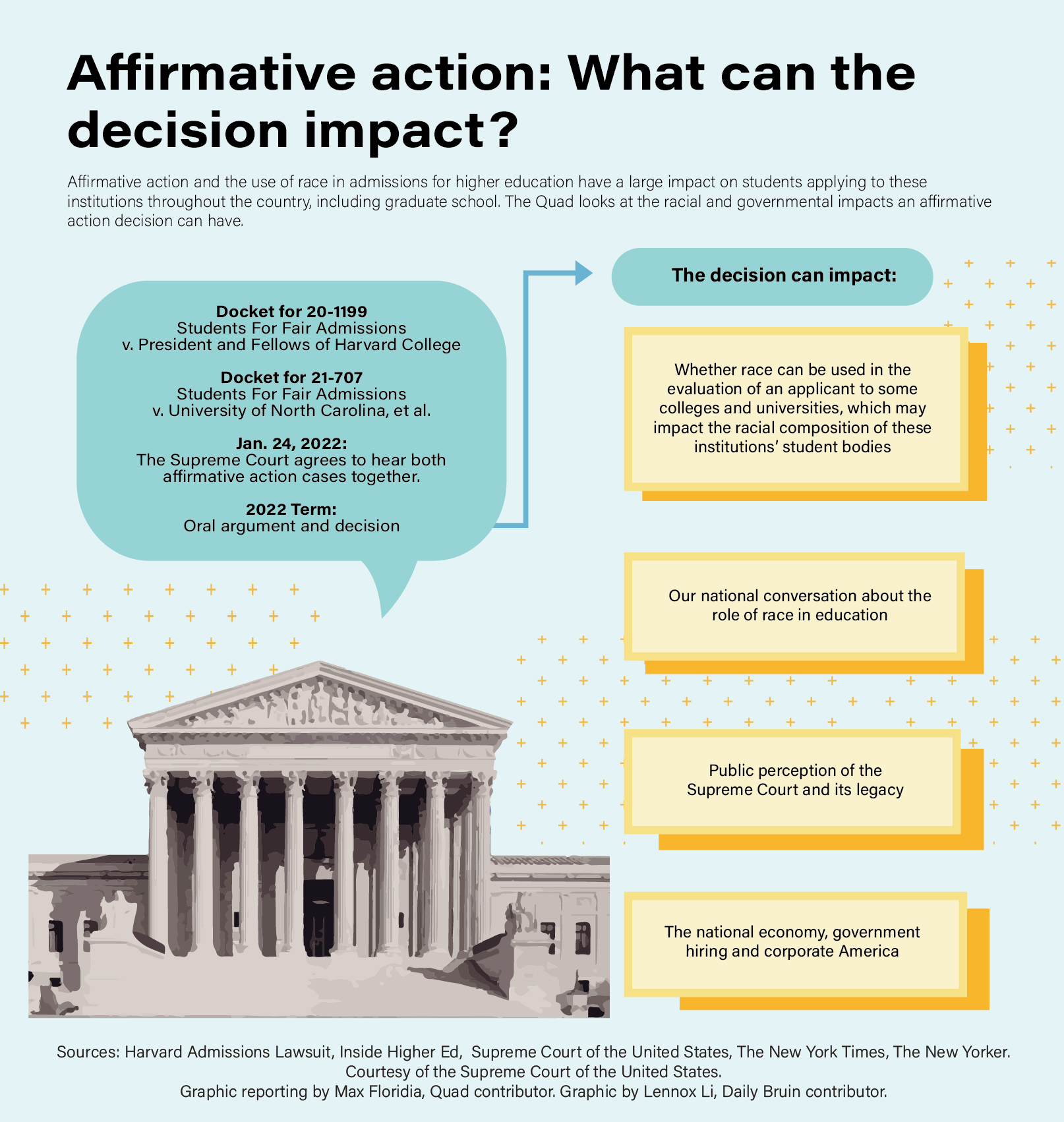The Quad: Discussing outcomes of Supreme Court’s upcoming decision on affirmative action

By Max Floridia
March 4, 2022 10:15 p.m.
This post was updated March 5 at 3:16 p.m.
The long-discussed question of affirmative action will soon be before the Supreme Court of the United States.
Under Supreme Court precedent, colleges and universities have been allowed to consider an applicant’s race with the intent of admitting a racially diverse student body.
But two new cases, Students for Fair Admissions v. President and Fellows of Harvard College and Students for Fair Admissions v. University of North Carolina, allow the court to revisit the question of whether colleges and universities are permitted to explicitly use race as an admissions factor.
The Supreme Court announced in January that it would hear these two cases. Oral arguments are scheduled for the court’s new term that begins in October.
Sylvia Hurtado, a professor at the UCLA School of Education and Information Studies, said in addition to bringing diversity to campuses, affirmative action has fostered social mobility for marginalized groups.
“The benefits … are social mobility for many different racial groups and also for low-income students. … (Selective institutions) place their students well into the job market,” Hurtado said. “So the opportunities have been tremendous and extremely beneficial to each of the states in terms of lifting their economies.”
Eddie R. Cole, an associate professor of higher education and history, said affirmative action’s meaning in practice has changed since its original conception in the early 1960s. He added that much of the dialogue around affirmative action currently centers on the same highly selective universities, such as Harvard and Yale.
“What we have to think about is how do we move away from thinking about these same institutions and actually think about affirmative action in its original intent, which was to create more opportunities for people to find access points to higher education,” Cole said.
According to court filings from Students for Fair Admissions, race-conscious admissions constitute racial stereotyping and are especially discriminatory toward Asian Americans.
Furthermore, ending affirmative action will allow each applicant to be evaluated as a distinct person, according to a Students for Fair Admissions statement released when the Supreme Court granted review.
Jim Newton, the editor-in-chief of the magazine UCLA Blueprint, said affirmative action may face closer scrutiny now that it is before the Supreme Court.
“It is safe to say that any program that relies in any way on race as a factor is going to be viewed skeptically by at least a number of justices,” Newton said. “Whether there are five justices around that position or not, it’s hard to tell.”
Though it is not clear how the court will ultimately rule, it is generally accepted that the end of race-conscious admissions could mean a drop in the proportion of Black and Latino students and an increase in Asian American and white students, according to a New York Times article.
Mitchell Chang, a professor of education and Asian American studies, said in an emailed statement that in the absence of affirmative action, other aspects of the admissions process may change.
“I suspect that a SCOTUS decision to end race conscious admissions will prompt institutions to permanently suspend requirements for submitting test scores,” Chang said.
Cole said the court’s decision could come with impacts beyond the educational sphere.
“The idea of considering race and not just in college admissions but also in hiring practices means that this upcoming court decision is likely going to impact corporate America, colleges and universities, and possibly even government hiring at the local, state and federal level,” Cole said.
Cole added that President Joe Biden’s administration recently had to revise the language of its policy on environmental justice to avoid mentioning race directly and incurring legal roadblocks.
“Some federal policies even designed to address racism can’t even name race and racism in the policy itself,” Cole said. “So we’re in a very complicated era right now, and this court case is going to be significant in bringing clarity to which direction everything goes from here.”
The court’s decision to take the affirmative action case is occurring during a time when the percent of adults who view the Supreme Court favorably has declined by 15% compared to three years ago, according to a February survey by the Pew Research Center.
Newton said issues of race in education are currently prominent issues in American politics, and the court’s decision will have ramifications for its own legitimacy.
“As a general matter, it is threatening to the court to be seen as simply responding to politics and not being guided by precedent,” Newton said. “I think the court is wandering into areas in which that is perilous for its reputation.”
But regardless of the final decision, some see this as an opportunity to change how the public perceives higher education and the admissions process in general.
“I hope that one outcome of this case will be that the public begins to place less premium on going to certain colleges and appreciate more the wide range of institutions out there that could potentially be a better educational match for college applicants,” Chang said.


